Product-Market Validation: A Step-by-Step Guide
Learn from an expert in product market validation why it is so important to validate your product idea before developing the actual product. You will also learn how to harness Facebook advertising to prove the appeal of your product, and to identify who exactly is willing to buy it.

This article is based on a conversation with Ivo Kalburdzhiev, the founder of CreatorClub, which helps hardware startups to run successful crowdfunding campaigns on Indiegogo and Kickstarter.
Many first-time entrepreneurs start out with an idea and then jump right into building it. That was me 10 years ago. I had this brilliant idea and decided, I’m going to do this.
I went to the bank, took out a loan, and spent $50,000 and three years of my life building something that nobody wanted.
Despite how painful that experience was, I wouldn’t wish it away, because it taught me some valuable lessons about crowdfunding and launching products, and it’s what brought me here today, to try and help you avoid making the mistakes that I made.
Statistics show that 80% of startups fail, and this is across many industries, including hardware and physical products. Failure is often caused by the lack of consumer demand.
We know that many products take several months to develop. The average is about 15 months, but in my case it was more like 36. I spent literally three years on the development of my product.
Costs will vary a lot, but it can easily cost six figures to develop a product and launch it into the market. So you need to be very careful before you make the decision to bring something to market.
A decade ago I started a company, KOLOS, that failed miserably on Kickstarter, because I built something that nobody wanted. It was a steering wheel for playing racing games on an iPad.
I thought at the time that I was a genius, that there was nothing like it out there, and that everyone would want it. I thought it would be the next big thing!
I plowed all of my time, money, and energy into this project for three years. But when I launched it on Kickstarter, I realized I was building something that nobody actually wanted.
A much bigger failure than mine was the widely mocked Juicero. This is a product that literally didn’t solve any need.
It was a WiFi-enabled machine that used proprietary, single-serving packets of pulped fruits and vegetables that subscribers received in the mail.
It looked pretty interesting and cool, but it turned out that you could take the pulp packets and squeeze them yourself, with your bare hands, to produce the same results as the expensive machine.
When someone took the Juicero apart, they saw how complicated the internals of this thing were.
It took hundreds of engineers to design the Juicero and it raised over $100 million in venture capital—all of that for something that essentially had no purpose.
The Juicero’s many components (Photo by Steve Jurveston)
The company folded after 4 years. I think the right word is, “Oops.”
The whole idea behind product-market validation is to make sure you’re building something that people want before you actually build it.
Another of my own failures, many years ago, was this phone stand.
Even this image itself wasn’t very good. You can’t really understand what we were selling. It was just a normal, nice, minimalistic-looking stand for your phone.
We spent so much time and money on this product and had 20 to 30 people involved in this campaign. We tested it in South Korea, where it seemed to be working.
We made assumptions, based on previous demand, that this would sell like hot cakes. We set the price at $99, because that’s what had worked in the past.
We only managed to raise $17,000 after a 30-day crowdfunding campaign, which was a big failure because we spent so much time, money, and energy building the video, building the website, building the whole strategy around it, only to raise $17,000.
We learned several lessons from all of that. First of all, we needed to validate the market demand before we launched something to the public. That’s the number one priority.
We also needed to test different price points. We had launched the phone stand at $99, but that price point was way too expensive. People were not willing to pay $99 for a phone stand. It’s just too much.
So, you have to make sure to set a price people are willing to pay.
I also learned that we needed to either find the product-market fit before moving forward, or we needed to iterate the product until we got to a point where it actually made sense to sell the product.
In the case of the failed phone stand, we didn’t evolve and do a second version.
Our process at Creator Club, and what we teach, is that you need to work on your value proposition—the features and benefits for the customer—until you find the product-market fit.
The biggest takeaway is that you should only launch validated products that will actually sell when you go to market.
Whether you are running a crowdfunding campaign or opening an e-commerce site, when you launch something, it needs to have been validated already.
After validation, your sales will always be easier, because you are selling something that people actually want to buy.
In many cases, first-time entrepreneurs do exactly the opposite. They don’t test their products or ideas. They jump straight into building the actual product and going straight to market.
They spend all their time, money, and energy on manufacturing and production—setting up the first production run, figuring out the minimum order quantities and pouring huge amounts of money and energy into something that may not even sell. That’s problematic.
Reservation Funnels
In general, a digital marketing funnel involves identifying the steps that visitors to your website must take to move from being a prospective customer, to an actual paying customer.
I’m going to describe what I call the reservation funnel that my company uses with all of our projects.
You should use this strategy too, if you want to make sure you’re building the right thing and that people are willing to pull out their wallets and give you money.
First, we bring traffic to a landing page. A landing page is any page on a website that has traffic funneled to it. Your homepage, where you host your product, is usually going to be your landing page.
Send any traffic from your ads with places like Facebook and Instagram to this landing page which features your product. You want to have a description of your product, product images, and maybe some video.
I should add that of all the ways you can advertise, Facebook and Instagram ads are the quickest and most effective way to get instant traffic to your page once you launch your advertising campaign.
After someone signs up on your landing page, they become what we call a “non-VIP lead.” This means they have become email subscribers.
You can immediately send these people an email survey asking them several questions (we’re going to discuss the questions in a bit).
After they’ve signed up, they’re taken to a second page, which is the VIP offer page. That’s where you can put down a deposit towards the price of the product.
Let’s say your product costs $500. An interested consumer can become a VIP if they put down a deposit of, say, $10, to guarantee that they’re going to get the lowest price when the product goes live, either on a crowdfunding platform or through e-commerce.
You can set that at $1 or $5 or $10, depending on the price point of the product. If it’s a higher-priced product, we recommend charging a bit more, but $10 is a good ballpark starting point.
If someone reserves that amount, then they become a VIP lead. (I’ll discuss later which tools we use to set all of this up). Both VIP leads and non-VIP leads get surveys which you can use to understand more about who these people are.
There are four main components I’m going to discuss. These are advertising, the landing page, the reservation page where the VIPs can put down a deposit, and the feedback surveys.
Advertising
It all starts with advertising. Let’s use one of our products, called DuoVox, as an example. It’s a camera that records video in color at night.
You can use it for security, to take pictures of wildlife, as a dashboard camera, and for many different things.
You can go to our website where we’re currently doing email signups and allowing people to put down a deposit towards the campaign that we’re launching with this product.
We’re using advertising to test different audience segments that we think this product would appeal to, to see what works.
We set up all of these different audiences, such as “driving” or “security camera” or “animal photography” to test what audience is going to work the best, and where we’re going to get the highest conversion at the lowest cost.
The next thing we do with each campaign is test different visuals. We use maybe 20, 30, or even 40 images at the same time with Facebook Advertising. This allows us to understand what visual resonates with each specific audience.
Then we test different messaging. Different messaging will work better with different audiences.
For example, the messaging for photographers will be completely different than for people who would use it as a dashcam or home security camera.
They might all benefit from the camera’s ability to see and detect movement in the dark. But the messaging and the visuals for each of these audiences needs to be different.
These are the core elements of effectively using Facebook Advertising. Most importantly, you need to optimize after you’ve launched your campaigns.
You have to tweak the messaging and the visuals so that you find the most optimal ads that are working, and don’t bother with everything else.
That’s a high-level overview of what we do. We offer more advice in the Creator Club, where we help startups run successful Kickstarter and Indiegogo campaigns. We go into greater detail about how to run your own advertising.
But this should give you a good place to start when you’re running your own advertising campaigns.
Landing Page
The next core element is the landing page. As we said, the landing page in most cases is your homepage. That’s where you send all your traffic.
The landing page for our example, Duovox Mate, explains what the product is and shows the different use cases, like city photography, wildlife photography, etc.
You want to describe all of these uses in great detail so that people can fully understand what you’re selling and how it’s going to benefit them.
With Duovox Mate, we talked about the advantages of the product compared to an iPhone or a GoPro, because those would be the main competitors.
It’s important to note that we don’t show a price. We are simply prompting people to reserve their launch invite, whether that’s for a launch on a crowdfunding platform or via e-commerce.
We don’t show a price because we want to understand whether there is interest in the product itself.
If we put the price up, and people don’t subscribe, then we’re not going to know whether it’s due to the product itself or the price. You need to first determine if you’re selling a product that people are willing to pay for.
At this stage, you can only sign up to be the first to know about the launch and to get, in our case, the super early bird price, because we’ll be doing a crowdfunding campaign.
If you don’t yet have the final product, you should create at least a prototype that looks like the real thing that you can use for your publicity images.
But you should always aim to show the real product. Showing just a rendering will result in poorer subscription rates.
For example, we started with the first iteration of Duovox Mate several weeks ago, and our conversion rate was about 10%-12%.
The conversion rate is the number of people who signed up for their email list, so 10 to 12 people out of 100 signed up.
When we replaced the renderings of footage from Duovox Mate with real video taken with the camera, our conversion rate skyrocketed.
People these days are sophisticated enough to understand when something is photo-realistic and staged. When we made the change to real product photos, conversion rates went up to between 50% and 75%.
When you just have a rendering of the product, people might wonder if that’s really what they’re buying, and they are naturally more reluctant to subscribe.
I would always encourage you to work on a realistic-looking prototype. It doesn’t need to work how you intend the final product to work, but it must look like the final thing. Also, make sure your photos are really good.
There are many tutorials on YouTube that can give you tips on how to take nice product shots, but if you have the budget, invest in a professional photoshoot.
Always aim to have a photoshoot in the natural environment of your product. If it’s an e-bike, shoot it maybe in the city, maybe in the mountains.
Reservation Page
The next stage is the reservation page where people would put down a deposit to be the first to get the discounted price of the product.
In our case, Duovox Mate would sell for over $1,000 when it hits retail, but for the crowdfunding launch we’re discounting it to $599 if you put down a deposit of $10.
After you subscribe, you’re immediately taken to the reservation page.
This is where the magic happens. If you have a decent number of people reserving, then you’re on to something. If this page is not working well, you need to understand why it’s not working.
If not enough people are putting down a deposit, it’s usually because of the price. By “enough” I mean 10% at a minimum or more, more being better of course.
Currently, the Duovox Mate landing page is converting at maybe 20%, which is good. It’s not amazing. Amazing conversion rates are 40%, but they are rather rare. Keep all of these numbers in mind with your own landing page.
Feedback Surveys
Feedback surveys are going to help you understand more about your own product from your potential customers. There are some obvious questions to ask, such as “what did you like most about the product?”
I also like to ask, “what similar products have you owned before?” This question allows you to understand a customer’s past experience with a particular product, and you may learn why they weren’t happy with it.
“What feature would you like to see added to our product?” Consumers might think of some feature that you hadn’t thought of that is actually pretty cool and should be added to your product eventually.
Obviously, don’t just rush in and add a feature to a product that isn’t even released yet, because this will delay your development timeline and can complicate the product unnecessarily.
Be mindful before adding new features and be sure to understand if they’re really needed.
“What do you plan on using our product for the most?” This is another question I like to ask, because people might have use cases that you haven’t even considered.
In our Duovox Mate example, you might think that people will use it to photograph wildlife, but in reality your feedback shows that more people will use it when fishing, to see where the fish or other boats are located, for example.
The assumptions that you have about how people would use your product are not always correct, so be sure to solicit regular feedback.
Presentation & Customer Feedback
I worked with a product called Blank Mask, which is an egg-shaped, weird-looking mask, which raised $500,000 on Indiegogo!
The subscription rate was over 20%. The reservation rate was over 2%, which is quite a significant achievement, and the prelaunch metric, which we’re going to discuss in a bit, was 9%.
Before we ran this campaign, we didn’t really expect the Blank Mask to do so well, but it actually did. It’s all in the numbers, so trust them. Numbers don’t lie, however funky and quirky a product might look.
What actually matters when you’re at this stage of your journey—the product-market validation stage?
Product presentation and customer feedback matter the most and are much more important than the branding and the landing-page design.
You don’t need to focus on branding at this point in time. It’s too early. Don’t spend time and money on it.
What actually matters is the product presentation, which includes how you present your product, the copy you’re using to position your product, and the pictures and videos you’re using to showcase your product so people can best understand what your product actually does and who it might benefit.
The other thing that matters at this stage is customer feedback. People might immediately have questions about the product.
You should make it easy for them to ask those questions, because customer questions are a valuable source of feedback on your product.
You can even install a “chat” function on the landing page. A chat function can be a bit clunky, but it works. There are some free tools that you can use for that.
The questions that people ask can guide your decisions about upgrading your landing page.
Maybe a feature isn’t clear or maybe something else needs to be updated. Use the feedback to optimize how your landing page represents the product.
Can I Make a Profit?
Here’s another crucial question you need to answer before you build a product and launch it into the world. Is this something I can sell to enough people at a price they’re willing to pay?
It’s all well and good if you’ve tested the market and validated that there is, indeed, a market out there for your product at a particular price point. But it’s no good if you’re not profitable at that price.
Say your cost of goods sold (COGS) is around $100, and it turns out people are not willing to pay more than $100 to $200. You’re not going to have a sustainable business, because you won’t be able to scale the product for retail or e-commerce.
If your COGS (cost of goods sold) is $100, you will only be successful if the product sells for at least $350 to $400. You need to have enough margin to play with as you go through different avenues for selling your product, like e-commerce, Amazon, retail, etc.
That’s why this product-validation stage is so critical. This is how you’ll find out whether people will actually buy your product at a price that’s high enough for you to make a decent profit.
Target Audience
You want to target different audiences based on the use cases of the product. In the Duovox example, we went after professional photographers as well as amateurs who would enjoy wildlife photography.
But we realized there are other audiences too, like people wanting a security camera at home. So, we tested a whole bunch of different use cases to try and understand who the product is actually for.
With Duovox, we decided to go a bit broad and not focus on one specific target market because there are only one or two direct competitors that cover each of the different use cases.
However, this strategy might not always work if you are in a commoditized market. If you are selling something that many others also are selling, you need to have a big differentiator.
Let’s say you’re selling a shoe that is made out of a sustainable material, like coffee. Then your target market should not be everyone who wears shoes.
Instead, you should target people who are environmentally conscious and who care about their impact on the planet. That marketing campaign would be vastly different from selling a shoe to everyone.
Customer Interests
The other thing we do is targeting for interest. This is mostly for Facebook and Instagram, where you can target different interests that people have. This is another way to understand which bucket people fall into.
With the DuoVox, we targeted the interest category camcorders on Facebook. Other categories we chose were popular camera brands, like Canon or Olympus. We targeted all the big brands to see how people reacted.
Some of them converted better, some of them converted worse, so we killed everything that did not convert well enough.
Then, we combined multiple different interests. For example, we narrowed down to boating and fishing because some people fish at night, and they would probably use such a device.
Another initial interest of ours was Indiegogo, so we narrowed down to Indiegogo and Canon, and all the other camcorder brands. We could then track the click-through rate for these various Facebook interests.
This was then broken down further. We tracked the number of landing page views.
Then we determined how many of them became leads – people who signed up on the landing page. Lastly we tracked “purchases,” which is how many visitors put down an actual deposit.
Answers to your survey questions can give you more ideas about your customers’ interests.
One question on our survey was, “are you a professional photographer?” Many people answered “No,” which told us that amateur photographers should be interested too.
I strongly recommend conducting surveys to understand what your potential customers are actually thinking and doing right now. Then utilize that information when running Facebook and other ads.
Metrics for Product Validation
You want to look at several important metrics when validating your product. One is the price. You want to test out a lot of different prices, because your assumptions about price may not be accurate.
Another metric to track is the subscription rate, and how it may change over time. With DuoVox, our subscription rate literally doubled after we incorporated real images into our Facebook campaign.
You also want to look at how many people landed on the page, and how many of those people converted. You can then look at the advertising cost-per-lead by dividing the money that you spent, by the number of leads.
A high cost-per-lead might mean that your audience is too niche. If there is more competition for your own category, then you are also going to see more cost-per-lead.
However, it’s still possible to get decent cost-per-leads with enough optimization, visuals, and testing of the copy.
In general, the better you understand exactly who your customers are, the lower your cost-per-lead should be.
The metrics that matter even more are cost-per-reservation and the prelaunch metric. The cost-per-reservation is how much it is actually costing you, in ad-spend money, for someone to put down a deposit of $10, for instance.
The pre-launch metric is cost-per-reservation, divided by the price that you’re testing. You do not want this to be over 10%.
Your cost-per-reservation should not be too high relative to your price, and your pre-launch metric should not be above 10%.
If your cost-per-reservation is too high, naturally your pre-launch metric would also be high, which tells you that something is not working.
Keep tweaking parts of your funnel. Whether that is the price, the conversion rate, or the reservation rate, you need to be making tweaks to your funnel in order to get to a point where the pre-launch metric is under $10.
Tools
I wanted to give you a quick rundown of the toolsets that we usually use. The first one is Landingi, which is a traditional website builder with a focus on landing pages. There are plenty of others out there, but we use Landingi to set up our websites and pages.
We use Google Analytics to analyze the traffic, including demographics like where traffic is coming from, to get ideas to plug into Facebook later on, and to better understand conversion rates.
We use GetResponse to collect our emails, but there are plenty of similar tools and you can use any of them. We use Typeform to send out surveys, and Stripe to process payments.
It is quite a straightforward process to sign up for Stripe. You can even use Stripe Plus to set up a US-based company for $500. We did that for some of our companies, so that is quite handy.
I would also encourage everyone to check out the tool I have built at Prelaunch.com that combines all of these functions, so you don’t have to deal with each one individually.
Conclusion
Do not expect to get remarkable results right out of the gate. You need to do a lot of testing and go through a lot of trial and error.
And do not forget that none of it is going to be easy. If it were easy, everyone would be rich and have products on the market.
Expect this stage to be like every other aspect of bringing a product to market. It is not going to be trivial, and it is going to take some time to get it right.
But the product validation stage is so crucial. You want to spend more time and energy on this at the beginning, not the end, of your journey.
Otherwise, you will end up like me with my first startup, spending so much time and money on building something that nobody wanted.
Spend time on the validation. Make a nice prototype, have a well-done photoshoot, and put up the website. It doesn’t have to be perfect, it just needs to get the job done.
Then, fire up the Facebook ads, drive some traffic to your website, and try to understand people’s reaction to your product.
It is much more valuable to spend time validating your idea, rather than building your idea in isolation.


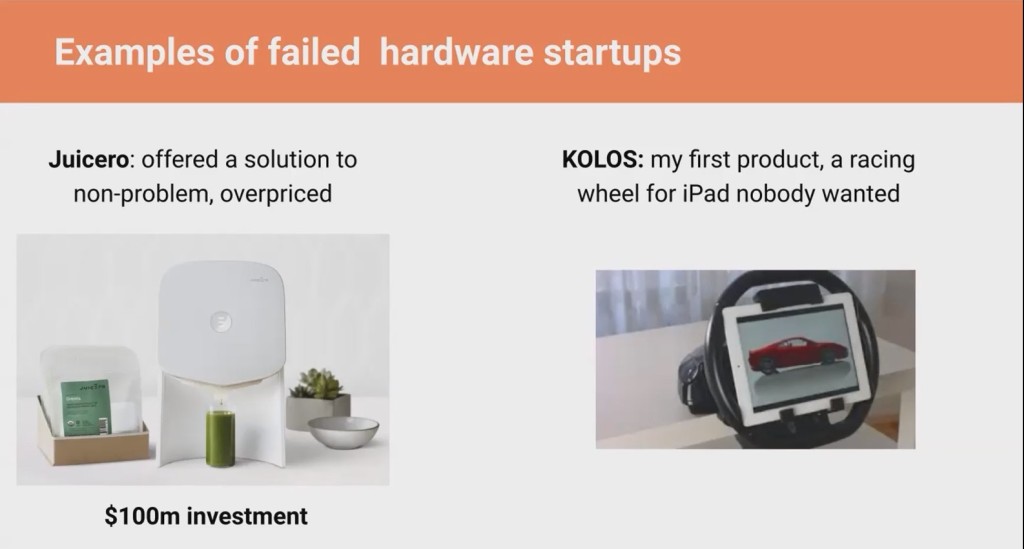

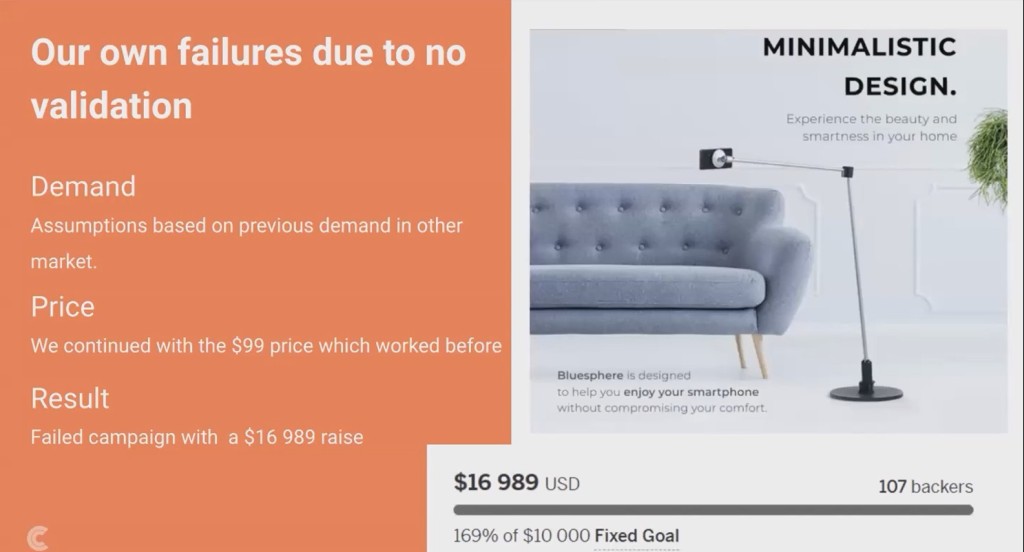

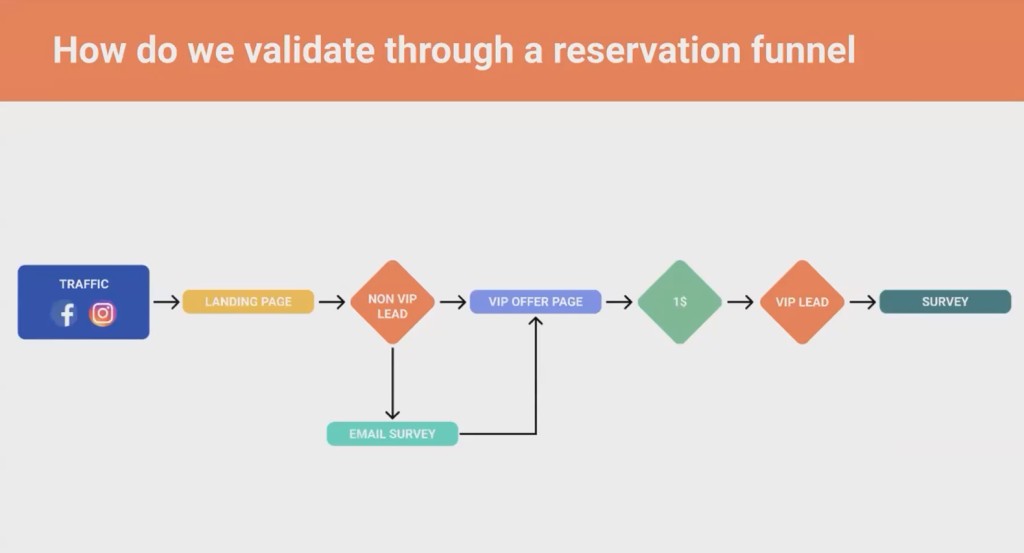
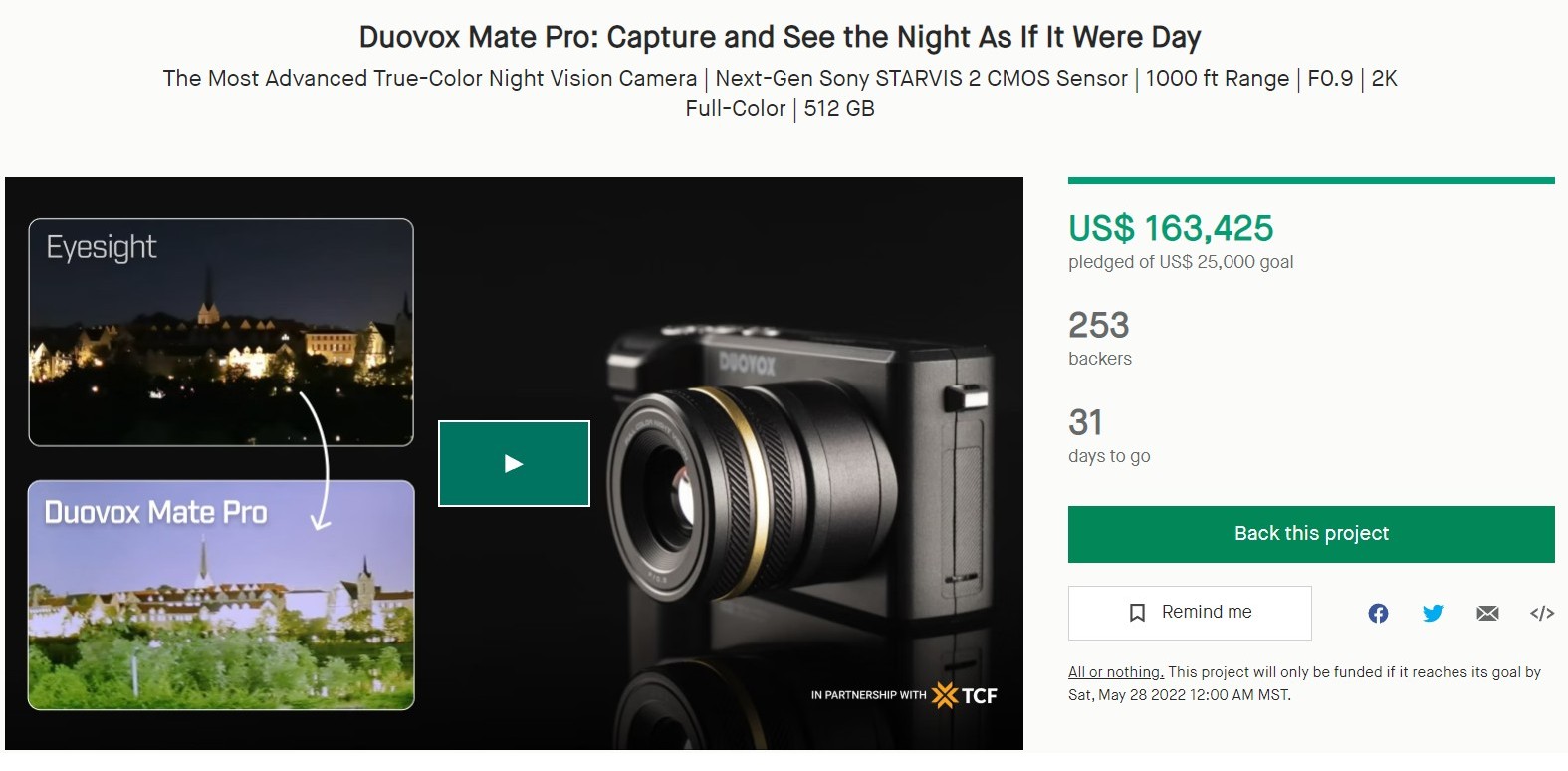
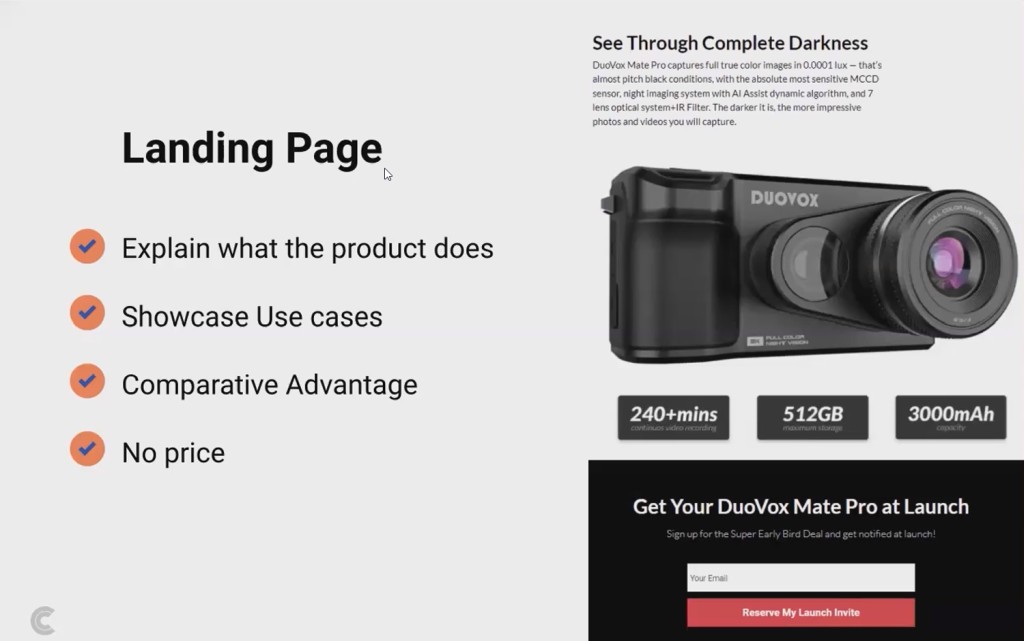
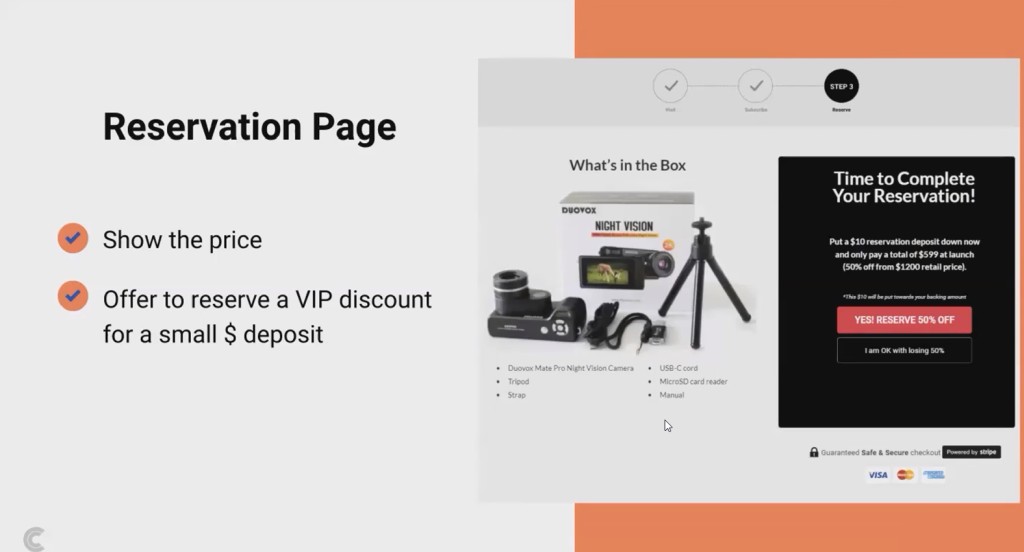
I have the following issues with the Creatorclub’s sales pitch:
1.
“With Duovox Mate, we talked about the advantages of the product compared to an iPhone or a GoPro, because those would be the main competitors”
A bulky Camera that uses a specific Sony Sensor designed for security cameras, is not in the same product category as an iphone, Go pro, Sony A7. Highlighting the benefits of your apples with another company’s oranges means you haven’t identified your target audience.
In the kickstarter page it says “as seen on”, then shows the logos of Wired, The verge etc…
well….
this is what the Verge article says about the the Duovox:
”
Just don’t expect the image quality to hold up for still photography. The sensor is only 2K resolution, and the odds are really stacked against the Mate Pro when you compare it to a smartphone night mode that makes use of complex algorithms and a modern image signal processor. Duovox says it’s using advanced noise reduction, but the results are still very noisy…Poor image quality aside, the Mate Pro’s lens isn’t really ideal for general photography, either. The focal length is tight but the minimum focusing distance is long, meaning it’s not useful for taking photos of close objects. For snapshots and quick video clips, though, it does the job.
It’s better to think of the Duovox Mate Pro as a portable security camera than an artistic tool.”
https://www.theverge.com/2022/4/13/23023276/duovox-mate-pro-night-vision-camera-hands-on-kickstarter
–
what this shows, is that even if you get a BAD review from a reputable source, just say “as seen on”, to link The Verge, to your product, few people are going to check…this is how misinformation works.
2.
“I would always encourage you to work on a realistic-looking prototype. It doesn’t need to work how you intend the final product to work, but it must look like the final thing. Also, make sure your photos are really good.”
Kickstart says: “Our Rules state that when a project involves manufacturing and distributing something complex, like a gadget, we require projects to show backers a prototype of what they’re making, and we prohibit the use of misleading imagery.”
??
I’d say first make sure you can deliver, then make promises.
Hi Max,
Thanks so much for the feedback. My comments to your two points are:
1) Personally I don’t see an issue with saying “as seen on” for a publication that gave it a less than fantastic review. You are actually being more transparent by sharing both the good and bad reviews. Now if you said “as recommended by” then that is a different story. Even if not a great review, the fact that a well known publication even reviewed your product is worth sharing and shows that you have a real product for sale.
2) As for your second point, keep in mind he was only talking about images on your landing page for validating your product, and he was not referring to running a Kickstarter campaign.
Thanks again for the feedback!
Cheers,
John
Hi John,
Yes, you’re right but I felt it was a misleading, if the Camera is using a sensor developed for low light security cameras, then comparing prices with iphone 13 etc is not a strategy that is targeting the customers that will really benefit from the product, somebody might buy it thinking it is going to take photos like a Sony A7, then be let down.